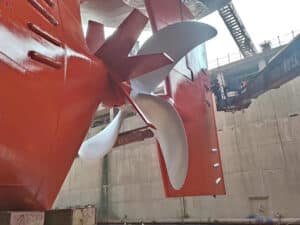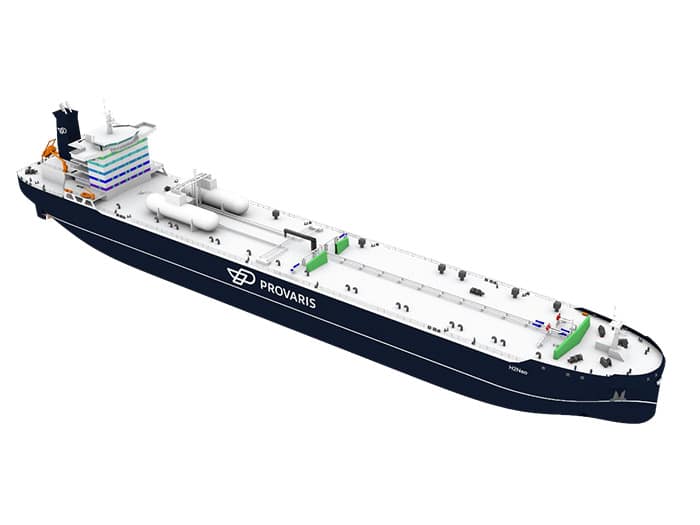
Provaris Energy moves ahead with compressed H2 carrier plans
Written by Nick Blenkey
Polaris says compressed H2 can deliver a safe, economic and energy-efficient hydrogen shipping and transport solution
Any transition to a green hydrogen economy will require the seaborne transformation of large volumes of hydrogen and Australia’s Provaris Energy Ltd (ASX: PV1) believes that shipping it in compressed high purity gaseous form is the way to go. Now the company, which was formerly known as GEV (Global Energy Ventures), has marked another major milestone. The American Bureau of Shipping (ABS), has reviewed, verified, and approved the design of its 26,000 cubic meter H2Neo compressed H2 carrier (H2Neo) and Provaris is moving ahead on shipyard selection planning.
The ABS approval follows the completion of extensive Front End Engineering Design (FEED) work and ABS review activities.
“It confirms that our innovative and cost-effective multi-layered hydrogen tank can be incorporated into our H2Neo Carrier and meets the requirements for ship classification,” says Provaris. “The next steps in our journey to world-scale hydrogen shipping are to construct and test a prototype hydrogen tank, and to prepare for ship construction with a selected shipyard(s).”
“The success of our FEED design stage and corresponding approval milestone is the result of extensive design and engineering works by Provaris’ team of discipline experts and consultants that have actively contributed to the development of Provaris’ innovative H2Neo hydrogen carrier,” said Provaris CTO Per Roed. “Through our close collaboration with ABS throughout this three-year process, we are confident that our compressed hydrogen carriers can safely and effectively establish the maritime transportation of hydrogen at a time when storage and transport remain key to unlocking markets with ambitions for hydrogen imports at scale from 2026.”
ABS senior vice president – global engineering and technology Patrick Ryan commented: “ABS recognizes the potential that hydrogen shows in supporting a sustainable, lower carbon future. Safe and efficient storage and transportation of hydrogen at sea will be critical to the development and viability of the global hydrogen value chain. We have been working closely with Provaris, initially granting AIP in 2021 and subsequently reviewing their comprehensive FEED level package for the H2Neo. ABS is pleased to award Provaris approval of their design, and we look forward to continuing this relationship into continued testing and construction stages of H2Neo carriers, including a yard selection process, and to support Provaris during ship operations on the numerous, interesting projects on the H2 horizon.”
“Compressed H2 can deliver a safe, economic and energy-efficient hydrogen shipping and transport solution that is essential to meet the climate targets for 2030 and beyond,” said Provaris’ managing director and CEO Martin Carolan.
“We expect this approval milestone to assist with the validation requirements in our commercialization pipeline, transition Provaris to construction award status in 2023, and de-risk the development and approvals pathway for our large-scale H2Max carrier and our design for hydrogen storage barges,” Carolan added.
The class approval milestone follows the completion of extensive FEED and critical safety studies
In October 2020, Provaris launched an ambitious program to develop a compressed H2 carrier, and in 2021 ABS awarded Provaris with an Approval in Principle (AiP) for two classes of green compressed hydrogen (GH2) carriers, namely the H2Neo (26,000 cubic meters capacity) and the H2Max (120,000 cubic meter capacity). Provaris aims to take the H2Neo through to construction-ready status in 2023, with the H2Max to follow 2026.
APPOINTMENT OF CLARKSONS FOR SHIPYARD SELECTION
Provaris has appointed the Clarksons newbuild team in London to work with it to undertake a shipyard selection and tender process as it moves towards the order of a fleet of H2Neo carriers.
“We are delighted to continue our relationship with Provaris, and we look forward to working together to ensure we select the right shipbuilding partner(s) for these vessels,” said Clarksons managing director S&P, Phil Harding. “We welcome the opportunity to really make great strides in the green transition and are committed to working together to achieve this goal of a better ship, a greener future and aiming to be on the right side of history”.
PROPRIETARY DESIGN AND INTEGRATION OF THE COMPRESSED H2 CARGO TANKS
The H2Neo design is characterized by two large-diameter cylindrical tanks, one in each of the port and starboard cargo holds with a maximum allowable operating pressure (MAOP) of 250 bar.

Provaris proprietary compressed H2 cargo tank
To avoid boil-off / cargo losses and to avoid the need for insulation and energy-intensive cooling during the voyage, the hydrogen is carried at ambient conditions. At these conditions, the design pressure rating of the cargo containment system has been determined to be 250 bar.
Provaris says the advantage of the patented design, and the company’s intellectual property, is evident in the ABS-approved solution of integrating a relatively thick steel layered tank (as required for 250 bar) into the hull of a relatively conventional ship- sized hull with low operating drafts. Leveraging its experience with gas and compression, Provaris has assessed various compressed cargo containment solution options, taking into account the characteristics of hydrogen, including MAOP (maximum allowable operating pressure) and temperature levels, and hydrogen embrittlement. These key parameters were considered in detail concerning safety, construction methodology / CAPEX and operations / OPEX.
According to Provaris, the tanks are designed so that they cannot suddenly rupture and release a catastrophic amount of energy. This is achieved by a cargo tank construction that is composed of layers of steel, nested together, including a stainless-steel inner layer to protect the high-strength carbon steel from hydrogen embrittlement. This nesting ensures that sudden through-wall cracks are impossible. Moreover, the layered tank construction benefits the construction methodology of the cargo tanks.
Additional safety measures are applied through continuous monitoring of the cargo tanks integrity. Using components and software that are proven, and readily available, in the market, Provaris has developed a monitoring system that will be installed on the outermost layer of the cargo tanks.




